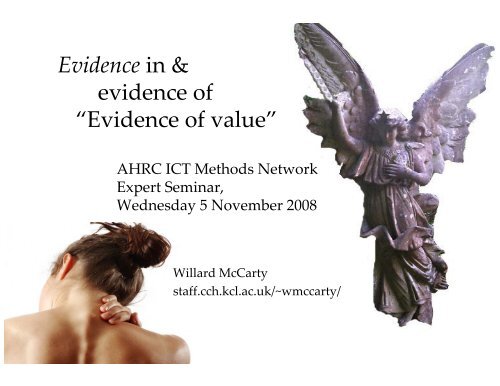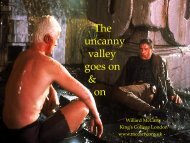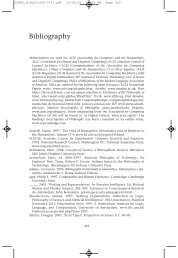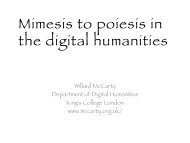X - Willard McCarty
X - Willard McCarty
X - Willard McCarty
Create successful ePaper yourself
Turn your PDF publications into a flip-book with our unique Google optimized e-Paper software.
Evidence in &<br />
evidence of<br />
“Evidence of value”<br />
AHRC ICT Methods Network<br />
Expert Seminar,<br />
Wednesday 5 November 2008<br />
<strong>Willard</strong> <strong>McCarty</strong><br />
staff.cch.kcl.ac.uk/~wmccarty/
Hung Far Low<br />
restaurant,<br />
Chinatown,<br />
Portland, Oregon
The phrase<br />
<br />
8 th in Google’s list of 914,000 hits, most of which on the question<br />
of what counts as evidence for policy decisions (on social issues,<br />
such as medical care), with frequent reference to evidential “gold<br />
standards” (Bullock 2004);<br />
<br />
<br />
<br />
Huge debate as to what these might be, about definitions of<br />
evidence, distinctions among kinds and consensus on when to<br />
use what – and who decides;<br />
All of which suggests a ripple of anxiety triggered by a catchy<br />
corporate slogan;<br />
Conclusion: “evidence of value” is not an answer but a question,<br />
and not a question about where to find it but about what we think<br />
it is, which implies the question of the argument it is intended to<br />
support and to whom this argument is being made.
Argument, reasons & evidence<br />
Some provisional distinctions:<br />
Argument: a process of reasoning; a statement advanced to<br />
influence the mind of an audience, to persuade its members<br />
to some action;<br />
Claim: the core of an argument; an assertion that something is<br />
the case;<br />
Reason: a premise in an argument; why an audience should<br />
accept a claim;<br />
Evidence: that which is to be accepted as fact in support of an<br />
argument; that which is evident to anyone who observes it.
Questions<br />
<br />
<br />
<br />
<br />
<br />
<br />
<br />
What is our argument? What are we claiming?<br />
To which audience(s) are we making this argument?<br />
To what end(s)? What are we envisioning, and why is it that<br />
we are envisioning anything at all?<br />
What’s the motivation? (So what?)<br />
What reasons do we have?<br />
What counts as evidence to support them to each of the<br />
audiences we address?<br />
How are the facts to be identified and gathered and made<br />
evident?
Cautions (why our question of evidence is important)<br />
<br />
<br />
<br />
<br />
<br />
Claims aren’t good enough, and a collection of them does not<br />
sum either to reasons or to evidence;<br />
Anecdotal testimony is useful, especially locally, but doesn’t<br />
travel well and doesn’t survive for long;<br />
Objects are mute, and software objects tend not to last very long<br />
(not even as long as most of us);<br />
Any academic activity not within the fundamental purposes of a<br />
university is highly vulnerable (NB the lamentable closing down<br />
of humanities computing centres);<br />
Asking the question of evidence has a long and mostly<br />
unexamined history; ignorance of that history cripples us<br />
because without it our practice has no autonomous identity and<br />
without that we are only what others say we are.
The history of asking<br />
Only the beginnings of an unshaped list:<br />
1962. Margaret Masterman, “The Intellect’s New Eye”<br />
1962. Ephim Fogel, “Electronic Computers and Elizabethan Texts”<br />
1964. Ephim Fogel, “The Humanist and the Computer: Vision and Actuality”<br />
1966. Louis Milic, “The Next Step”<br />
1967. Louis Milic, “Winged Words: Varieties of Computer Applications in Literature”<br />
1967. Norman Holland, “Futures: A Non‐Summary of the EDUCOM Symposium”<br />
1968. Diane Burton, “Respice Finem: An Essay Review of Computational Stylistics for 1967‐1968”<br />
1969. Robert Dyer, “The New Philology: An Old Discipline or a New Science?”<br />
1976. Roberto Busa, “Why can a computer do so little?”<br />
1978. Colin Martindale, “Sit with statisticians and commit a social science: Interdisciplinary aspects<br />
of poetics”<br />
1978. Susan Wittig, “The Computer and the Concept of Text”<br />
1979. Bruce A Beatie, “Measurement and the Study of Literature”<br />
1980. Roberto Busa, “The Annals of Humanities Computing”<br />
1980. Susan Hockey, A Guide to Computer Applications in the Humanities<br />
1981. John B. Smith, “Computers and Literary Theory”<br />
1982. Richard W. Bailey, “Computing in the Humanities”<br />
1984. J. David Bolter, Turing’s Man<br />
1984. John B. Smith, “A New Environment for Literary Analysis”
The history of asking<br />
1985. Bernard Derval and Michel Lenoble, eds., La Critique Litteraire et L’Ordinateur /<br />
Literary Criticism and the Computer<br />
1986. Thomas Corns, “Literary Theory and Computer‐Based Criticism”<br />
1987. Thomas Corns and Margarette Smith, “Literature”<br />
1987. R. A. Zwaan, “The Computer in Perspective: Towards a Relevant Use of the<br />
Computer in the Study of Literature”<br />
1988. Rosanne Potter, “Literary Criticism and Literary Computing: The Difficulties of a<br />
Synthesis”<br />
1988. Estelle Irizarry, “Literary Analysis and the Microcomputer”<br />
1989. Rosanne Potter, Preface, Literary Computing and Literary Criticism: Theoretical and<br />
Practical Essays<br />
1989. Willie van Peer, “Quantitative Studies of Literature: A Critique and an Outlook”<br />
1989. Northrop Frye, “Literary and Mechanical Models”<br />
1990. Steven DeRose et al., “What is text, really?”<br />
1991. Christopher Turk, Humanities Research Using Computers<br />
1991. C. M. Sperberg‐McQueen, “Text in the Electronic Age”<br />
1991. Thomas Corns, “Computers in the Humanities: Methods and Applications in the<br />
Study of English Literature”<br />
1991. Rosanne Potter, “Statistical Analysis of Literature: A Retrospective”<br />
1991. Paul Fortier, “Theory, Methods, and Applications”<br />
1991. Mark Olsen, “What can and cannot be done with electronic text in historical and<br />
literary research”<br />
1991. Joseph Raben, “Humanities Computing 25 Years Later”
The history of asking<br />
1992. Anthony Kenny, Computers and the Humanities<br />
1992. Jean‐Philippe Genet and Antonio Zampolli, eds., Computers and the Humanities<br />
1993. Computers and the Humanities 27.5‐6 (provoked by Olsen 1991)<br />
1995. David Miall, “Representing and Interpreting Literature by Computer”<br />
2000. Susan Hockey, Electronic Texts in the Humanities: Principles and Practice<br />
2001. Jerome McGann, Radiant Textuality<br />
2003. Literary and Linguistic Computing 18.2<br />
2004. Susan Hockey, “The History of Humanities Computing”<br />
2004. Thomas Rommel, “Literary Studies”<br />
2004. Jerome McGann, “Marking Texts of Many Dimensions”<br />
2005. <strong>Willard</strong> <strong>McCarty</strong>, Humanities Computing<br />
2007. David Hoover, “The End of the Irrelevant Text: Electronic Texts, Linguistics, and Literary<br />
Theory”<br />
2008. Patrick Juola, “Killer Applications in Digital Humanities”<br />
2008. <strong>Willard</strong> <strong>McCarty</strong>, “Perspectives of Literary Theory”
An example: Kenny 1992<br />
Stages of development<br />
1949‐1969: pioneering work;<br />
1970‐1984: pre‐designed packages; citations of use<br />
disappear; work done with(in) computing centres;<br />
specialised centres set up;<br />
1985‐1992: microcomputers in the study; e‐mail<br />
communication; resource construction; data on CD.
An example: Kenny 1992<br />
Levels of development: work that is<br />
humdrum, leaving few visible traces;<br />
most technically ambitious, undertaken for<br />
demonstration of method rather than<br />
enrichment of the domain of humanities<br />
research;<br />
central to the humanities ?
An example: Kenny 1992<br />
<br />
Little evidence of value: “surprisingly difficult<br />
to point… to solid, uncontroverted gains to<br />
scholarship … [T]hroughout humanities<br />
disciplines, after thirty‐odd years …<br />
embarrassingly few books and articles which<br />
can be confidently pointed out as passing”<br />
these criteria:<br />
1. Studies that are respected as an original scholarly<br />
contribution within their own discipline, and<br />
2. Could clearly not have been done without a<br />
computer.
How things look now<br />
Kinds of work:<br />
The humdrum may be part of the furniture but has<br />
problematic social and intellectual consequences whose<br />
informed study is beneficial;<br />
The most ambitious may have no immediate or obvious<br />
application to the humanities but feed methodological<br />
innovation and development –they comprise an<br />
important aspect of our research;<br />
Those central to the humanities? This is the question!
How things look now<br />
<br />
The criteria<br />
1. Respect<br />
a. In what disciplines & with what types of problems have we<br />
done well?<br />
b. What do those disciplines & types of problems have in<br />
common that would explain our success in them?<br />
c. What do the others share that would explain our failures in<br />
them?<br />
2. Sine qua non<br />
a. Distinguish acts that are inconvenient from those that are<br />
difficult to impossible;<br />
b. Observe principles of emergent order.
An example: Wittig 1978<br />
<br />
<br />
<br />
<br />
Early claim for the potential of computing: a<br />
“telescope for the mind” (Masterman 1962).<br />
This has not been realised. Why?<br />
Blame fixed on “the limited conceptual<br />
framework of New Criticism”.<br />
The central problem: “the concept of text”.
How things look now<br />
<br />
<br />
<br />
Exactly the same conceptual difficulty identified by<br />
Jerome McGann 2004, which begins with the question,<br />
“What is text?”<br />
McGann 2001: “the general field of humanities<br />
education and scholarship will not take the use of digital<br />
technology seriously until one demonstrates how its<br />
tools improve the ways we explore and explain aesthetic<br />
works – until, that is, they expand out interpretational<br />
procedures” (p. xii).<br />
A stalemate for those disciplines particularly concerned<br />
with the exploration and explanation of aesthetic works?<br />
If so, what do we do?
How things look now<br />
<br />
<br />
But note: evidence of value lies also in the theoretical<br />
questions raised by practical work, perhaps especially<br />
when that practical work has failed to live up to<br />
expectations.<br />
“Science in general… does not consist in collecting what<br />
we already know and arranging it in this or that kind of<br />
pattern. It consists in fastening upon something we do<br />
not know, and trying to discover it.... That is why all<br />
science begins from the knowledge of our own ignorance: not<br />
our ignorance of everything, but our ignorance of some<br />
definite thing....” (Collingwood 1993: 9).
An example: Milic 1966<br />
<br />
<br />
<br />
<br />
First fruits now to hand (concordances etc), “but satisfaction with such limited<br />
objectives denotes a real shortage of imagination among us. We are still not<br />
thinking of the computer as anything but a myriad of clerks and assistants in one<br />
convenient console… We do not yet understand the true nature of the<br />
computer.”<br />
Scholars’ shift toward that which can be done mechanically (i.e. most easily with<br />
the machine). Fear that computing will mechanize literary studies has blocked<br />
understanding of its “rich and genuine possibilities”.<br />
Computer is “neither a human brain nor a mechanical clerk… Its intelligence<br />
and ours must be made complementary.” Example of pattern‐recognition.<br />
Augmentation of human intelligence only if the computer “opens avenues we<br />
have not expected the existence of”.<br />
Next step: imitation of the process of literary composition [much early activity<br />
attested]; example of the gain in understanding from the failure of the machinetranslation<br />
project. Modelling human creative powers.
How things look now<br />
<br />
How far beyond the “myriad of clerks and assistants in one<br />
convenient console” have we come?<br />
<br />
<br />
<br />
<br />
Better educated and more highly organized clerks and assistants?<br />
A blurred distinction between them and us?<br />
A golem who teaches us?<br />
An environment within which we teach ourselves?<br />
<br />
<br />
Have we opened up “avenues we have not expected the<br />
existence of”? If so, in what disciplines? How has this been<br />
done?<br />
What form might the poetry‐writing project take that would<br />
allow us to explore human creative powers? (Cf. Masterman<br />
and Wood 1970)
Assertive recommendations<br />
<br />
<br />
<br />
Questioning ʺevidence of valueʺ is best done in its historical<br />
context. Our problem is that we are caught up in an endless<br />
round of forgetting what has been thought and said. The<br />
wheel we are perpetually reinventing is the asking of this<br />
question and the critical enquiry which has acompanied every<br />
asking of it.<br />
But for this particular asking, we need to identify our current<br />
audiences, clarify the claims we now think we can justify,<br />
strengthen the arguments which support them and commit to<br />
gathering the facts and shaping them into evidence.<br />
Making fine objects is not enough. Their value must be<br />
communicated in words, by the makers, in publications which<br />
the audiences in question will read.
Works cited<br />
Bullock, Merry. 2004. “What is Evidence and What is the Problem?” American<br />
Psychological Association Online 18.3 (www.apa.org/science/psa/mar4edcolumnprt.html)<br />
Collingwood, R. G. 1993/1946. The Idea of History. Rev edn. Ed. Jan van der<br />
Dussen. Oxford: Oxford University Press.<br />
Kenny, Anthony. 1992. Computers and the Humanities. The Ninth Annual British<br />
Library Research Lecture. London: The British Library.<br />
Masterman, Margaret. 1962. “The Intellect’s New Eye”. Freeing the Mind: Articles<br />
and Letters from The Times Literary Supplement during March‐June 1962. London:<br />
The Times Publishing Company.<br />
‐‐‐ and Robin McKinnon Wood. 1970. “The Poet and the Computer”. Times<br />
Literary Supplement 18.6: 667‐8.<br />
McGann, Jerome. 2001. Radiant Textuality: Literature after the World Wide Web.<br />
Basingstoke: Palsgrave.<br />
‐‐‐. 2004. “Marking Texts of Many Dimensions”. A Companion to Digital<br />
Humanities. Ed. Susan Schreibman, Ray Siemens and John Unsworth. 198‐217.<br />
Oxford: Blackwell.<br />
Milic, Louis T. 1996. “The Next Step”. Computers and the Humanities 1.1: 3‐6.<br />
Wittig, Susan. 1978. “The Computer and the Concept of Text”. Computers and the<br />
Humanities 11:11‐15.





